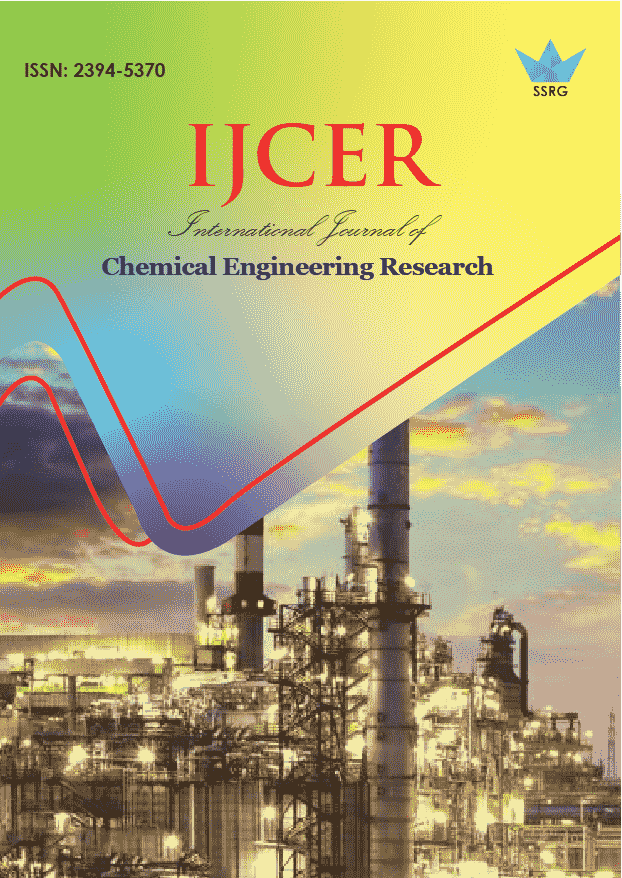Boron Carbide Contents Variation Effect on Shielding Properties of Styrene Butadiene Rubber Composites

| International Journal of Chemical Engineering Research |
| © 2020 by SSRG - IJCER Journal |
| Volume 7 Issue 2 |
| Year of Publication : 2020 |
| Authors : Hafiz Muhib Ullah Zulkafal, Muhammad Asif, Saima Kanwal, Muhammad Afzal Khan |
How to Cite?
Hafiz Muhib Ullah Zulkafal, Muhammad Asif, Saima Kanwal, Muhammad Afzal Khan, "Boron Carbide Contents Variation Effect on Shielding Properties of Styrene Butadiene Rubber Composites," SSRG International Journal of Chemical Engineering Research, vol. 7, no. 2, pp. 1-12, 2020. Crossref, https://doi.org/10.14445/23945370/IJCER-V7I2P101
Abstract:
The main objective of this experimental approach is to find out effect of boron carbide contents on shielding properties of composite material. The
Formulation of Styrene Butadiene Rubber composites have been prepared by using Boron Carbide contents, ranging from 5% to 25%. These composites have been subjected to various tests and experiments have been conducted to study thermal neutron shielding properties of these composites by neutron irradiation. Moreover, linear attenuation coefficient has been calculated from this data. Monte Carlo N-Particle transport code simulations have been used to compare the simulated results to experimental results. Mechanical properties such as hardness, swelling uptake studies, and thermal gravimetric analysis have been carried out, and it is observed that hardness increased 5% and swelling index values, specifically lower for water, decreased by increasing boron carbide contents. For thermal neutron shielding properties, graphs show the slope of composite with higher concentration of boron carbide is steeper than the one with lower amount of boron. Furthermore, both the experimentally calculated and MCNP estimated values are in good agreement. These results suggested that shielding capability of composites increases with the boron carbide amount. More the boron carbide content, less thickness of composite will serve the purpose of shielding.
Keywords:
Styrene Butadiene Rubber, Radiation Shielding, Polymer Composites, Boron Carbide, Neutron Shielding.
References:
[1] Madsen D. (2014). “Borated polyethylene-fire properties and other issues”. LUTVDG/TVBB.
[2] Shultis, J. K., & Faw, R. E. (2005). “Radiation shielding technology”. Health physics, 88(4), 297-322.
[3] Allison, J., Amako, K., Apostolakis, J. E. A., Araujo, H. A. A. H., Dubois, P. A., Asai, M. A. A. M., ... & Cirrone, G. A. P. (2006). “Geant4 developments and applications”. IEEE Transactions on nuclear science, 53(1), 270-278.
[4] Zulkafal, H.M., Asif, M., Yasin, T., Kanwal, S., Khan, M.A., & Iqbal, K. (2018). “Study of Thermal Oxidative Ageing and Gamma Irradiation Effects on Styrene Butadiene Rubber/Boron Carbide Based Composites”. Journal of Chemical Engineering & Process Technology 9(2) : 1000379
[5] Van Krevelen, D. W., & Te Nijenhuis, K. (2009). “Properties of polymers: their correlation with chemical structure; their numerical estimation and prediction from additive group contributions”. Elsevier.
[6] Klemm, D., Heublein, B., Fink, H. P., & Bohn, A. (2005). “Cellulose: fascinating biopolymer and sustainable raw material”. Angewandte Chemie International Edition, 44(22), 3358-3393.
[7] Haraguchi, K., & Li, H. J. (2006). “Mechanical properties and structure of polymer− clay nanocomposite gels with high clay content”. Macromolecules, 39(5), 1898-1905.
[8] Charlesby, A. (2016). “Atomic radiation and polymers: international series of monographs on radiation effects in materials.” Elsevier.
[9] Zali, N. M., Yazid, H., & Ahmad, M. H. A. R. M. (2018, January). “Neutron shielding behavior of thermoplastic natural rubber/boron carbide composites”. In IOP Conference Series: Materials Science and Engineering (Vol. 298, No. 1, p. 012018). IOP Publishing.
[10] Callister, W. D., & Rethwisch, D. G. (2000). “Fundamentals of materials science and engineering “(Vol. 471660817). London, UK:: Wiley.
[11] Makitra, R., Midyana, H., Yevchuk, I., & Pal’chykova, O. (2011). “Dependence of natural rubber swelling index upon organic solvents properties”.
[12] Mostafa, A., Abouel-Kasem, A., Bayoumi, M. R., & El-Sebaie, M. G. (2009). “Effect of carbon black loading on the swelling and compression set behavior of SBR and NBR rubber compounds”. Materials & Design, 30(5), 1561-1568.
[13] Emami, N., Sjödahl, M., & Söderholm, K. J. M. (2005). “How filler properties, filler fraction, sample thickness and light source affect light attenuation in particulate filled resin composites”. Dental Materials, 21(8), 721-730.

 10.14445/23945370/IJCER-V7I2P101
10.14445/23945370/IJCER-V7I2P101